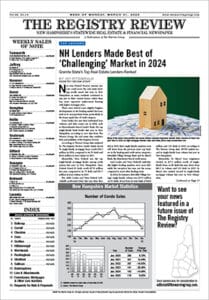
Office tenants’ efforts to find nicer quarters in the disrupted office market are being complicated by a lack of class A space, high build-out costs and a steady drumbeat of office-to-residential conversions. iStock photo illustration
One would think the current office market across the state would greatly favor tenants.
After all, vacancy rates are rising across the state, as many employers continue to downsize their office space needs, due almost entirely to the ongoing remote-work phenomenon.
With lower occupancy rates, tenants should have the pick of the office-space litter, so to speak, and at lower lease prices.
Think again.
The post-COVID office market is simply not following normal supply-and-demand trends in New Hampshire, industry observers say.
Softening office space demand hasn’t always led to lower lease prices. Indeed, overall office rental rates have increased by 15.6 percent over the past five years, according to Colliers’ second-quarter report on New Hampshire’s office market.
Meanwhile, as the Colliers report notes, tenants are finding it hard to secure “space that fits their needs,” particularly smaller tenants hoping to trade up to higher quality spaces in some areas of the state.
And to top it all off, office market dynamics can vary greatly from submarket to submarket in New Hampshire, even down to variations within neighborhoods within submarkets, industry officials say.
“It’s a very odd time,” Larry Hirsch, co-owner of Hirsch & Company LLC, a commercial real estate brokerage in Merrimack, said of the overall office market.
“It’s almost getting down to the granular level,” Bob Rohrer, managing director of Colliers-New Hampshire, said of office deals that can vary from location to location, depending on very specific market characteristics of an area.
In sum, things are making a confusing office market even more confusing, for both tenants and landlords alike.
‘Flight to Quality’ – If You Can Find It
Nationally, industry leaders say that the opening up of office space across all asset classes has led to some tenants “trading up” to higher quality buildings, as they seek to take advantage of current market conditions.
To a certain extent, the same “flight to quality,” as it’s also known, has been happening in New Hampshire, market-watchers say.
And it certainly appears there should be plenty of class A space available for those tenants wanting to move into higher-quality digs across the state.
According to Colliers, the state’s overall office vacancy rate rose year-over-year by 2.3 percent in the second quarter, to 13.5 percent. Class A buildings really took it on the chin last quarter, with their collective vacancy rate rising by 8.5 percent.
But that rise in class A empty space is almost entirely due to Liberty Mutual’s recent decision to vacate more than 575,000 square feet of space at its office campus in Dover.
That higher-quality space may be available to tenants wanting to move up to class A space, but they’d have to relocate to Dover to secure it.
A ‘Blurred’ Line Between Classes A and B
The “flight to quality” trend is definitely real, but it’s been hampered nationally by a shortage of recently built class A space, defined as offices constructed within the past 10 years and with most modern amenities included.
The bottom line, nationally: The demand for better digs is outstripping the supply of class A space in some areas.
In New Hampshire, the class A problem is even more complicated.
There’s been very little class A office space built within the past 10 years here. Much of what today is locally called “class A” arguably could be called “class B,”, making it challenging and confusing for some tenants looking for higher-quality spaces.
“You do hear that class A space is benefiting from [flight-to-quality demand],” said Rohrer. “But in New Hampshire, the line between class A and class B is blurred.”
The office market picture is made more confusing by the fact that many tenants simply don’t know how much space they’ll truly need moving forward.
What type of “hybrid” work plan will employers, big and small, be using? How many days a week will employees be required to work on-site versus working from home? How much space should a firm ultimately lease?
“People are asking basic questions about what they’ll need,” said Bill Norton, president of Norton Asset Management in Manchester. “Do you provide individual offices for some employees? How many desks and chairs do you need? Do you do an open-floor plan?”
Rising Costs Push Against Relocations
One might presume vacancy rates would be high and lease prices lower in Manchester, by far the state’s largest office submarket.
But Manchester’s overall office vacancy rate is only 6.5 percent, far below the state average, and its direct rent is running at a solid $21.22 per square foot, according to Colliers.
Part of the reason for Manchester’s strong numbers: Some major office buildings in the city have recently been converted to residential facilities, thus reducing the city’s overall supply of offices, keeping vacancy rates lower and leaving office lease prices strong.
And more office-to-residential conversions are on the way, such as at the old Wellington Trade Center at 25-27 Lowell St., which was recently sold to North Street Properties and which the new owner tentatively plans to convert into 76 residential units.
Lease prices aren’t the only costs either staying the same or increasing in some submarkets.
Office renovation costs have become “prohibitive” for many tenants, due to skyrocketing construction prices in general, said Norton.
Meanwhile, landlords and tenants are constantly tussling over who should be paying for higher inflation-driven operational costs, such as for utilities, insurance, property taxes and other items, Norton said.
“There’s so much going on today,” Norton said about the statewide office market in general.
“There are so many questions. There’s a lot for tenants and landlords to think about. It’s all about their [financial] exposure. There are so many new issues at stake today.”

